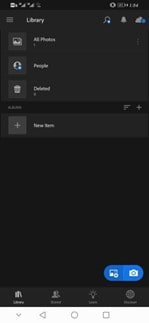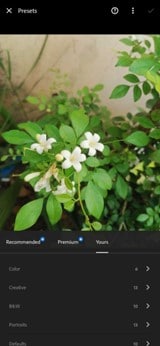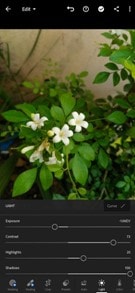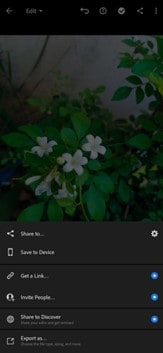![[Updated] Complete Breakdown The Android Adaptation of Lightroom App](https://thmb.techidaily.com/11a5b5bdf5c605b4fbfac8e2beadd347faae794edca9da0873a40e49d2c700e6.jpg)
"[Updated] Complete Breakdown The Android Adaptation of Lightroom App"

Complete Breakdown: The Android Adaptation of Lightroom App
Despite newer editing software programs being available, the Adobe Lightroom Android app continues to be a popular choice for many photographers. Moreover, the app’s simple design and all-in-one workflow provide an efficient way to import, edit, organize, and output images.
| Advantages | Disadvantages |
|---|---|
| Presets for color correction | No plugin or printing support |
| Available for PC and Android devices | Sharing feature is limited |
| Clear and simple interface | Layer-based editing is not available |
| AI-powered fast features | |
| Extensive images/files organization and management | |
| Safe to use |
Part 1. What is Lightroom App?
If you’re a serious photographer or just enjoy taking and editing photos, the Lightroom Android app is definitely worth checking out.
The app allows you to perform various tasks, from basic photo editing to more advanced functions like creating presets and customizing your workflow. You can also use Lightroom to manage your photos and keep your library organized.
Download: You can download Lightroom from the Play Storeon your Android device.
Price: Lightroom photo editing app offers a free version with basic features at your disposal and a premium version with seven days trial, 1TB of storage space, and two subscription options: $99.9 per month and $119.88 per year.
Part 2. Key Features Of Lightroom App on Android
Following are some of the key features of the Lightroom app on Android are:
Resourceful Photo Presets And Filter: Various free preset filters are available in Lightroom to assist you in fast and easy editing of your photos. If you’re stuck for inspiration, let AI suggest the ideal preset for your image. Additionally, 200+ premium, exclusive presets made by accomplished photographers are available to help you improve your appearance.
Non-destructive Editing: Lightroom lets you make changes to your photos without permanently altering the original file, which means you can always go back and make changes if you’re unhappy with the results.
RAW support: With the Lightroom app, you can edit RAW files from your DSLR or mirrorless camera, which gives you more control over the final outcome of your photos.
Color Presets: The app comes with a range of color presets you can use to edit your photos quickly. Furthermore, you can also create your own presets and share them with other users.
Cloud Backup: With cloud backup, you can keep your photos and edits safe and sound in the cloud and access them from your tablet, desktop, or mobile Lightroom versions.
Part 3. How To Use Lightroom App?
Here’s the step-by-step guide to help you edit your pictures like a pro with the Lightroom Android app:
Step1 Install the app using the Google Play Lightroom link provided above and launch it. Sign in using your Facebook, Google account, or Adobe ID.
Step2 Once signed in, tap the Import icon and select your picture to import. Next, open a picture you want to edit, and editing tools will appear at the bottom of the screen.

Step3 To improve your picture’s composition, tap “Crop” and set the ratio or drag the handles to adjust the size. Tap the check icon to accept the changes and apply them to your picture.
Step4 From the adjustment menu, tap “Preset” and select the filter effect from the categories. Select “Preset” and tap “Check Mark.”

Step5 Next, tap the “Light” option, and drag the slider to adjust the Contrast and Exposure. Moreover, you can also adjust the Shadow and Highlight to increase or decrease the contrast.

Now, tap “Color” and use the sliders to adjust the Temperature and Saturation on your picture. Tap the “Check” icon once you are done.

![]()
Note: Lightroom also offers a redo, undo, and reset option to help you stay on track.
Step6 Once satisfied with your edits, click the “Share” icon and tap “Save to Device” to export the picture. You can also use the “Share to…” to share your file with your friends or family or “Export as…” to get specific file types, dimensions, and quality.

Part 4. Advantages and Disadvantages Of Lightroom App For Android
The Lightroom app for Android has a variety of features that can be useful for both amateur and professional photographers. However, the app also has drawbacks that you should be aware of before you download it.
Advantages: Lightroom is designed to be intuitive and easy to use, even for those who are not familiar with photo editing software, and offers a wide range of editing tools such as color correction preset, preset filter effects, crop, details, optics, masking, and healing. Moreover, an Auto (preset color correction) tool is also added, which can help you fix your picture automatically.
The Lightroom app offers cloud support and a picture library that keeps your data in sync between your devices to help you access it anywhere, anytime. The app also provides an extensive export feature that allows you to set file type, quality, and dimension before saving the picture on your device.
It also provides you with non-destructive editing capabilities and RAW support features. These features allow you to edit their photos without permanently altering the originals and retain your RAW photos’ full quality.
Disadvantages: Lightroom does not support printing or plugins. You can’t print your photos directly from the app, nor can you use plugins to add extra features. The app doesn’t have layer-based editing. Therefore, you can’t make complex edits to your photos on the go.
Furthermore, the sharing feature is limited and does not allow you to share your picture directly with the Adobe Discover photo-sharing community.
Note: Despite these drawbacks, Lightroom is still an excellent option for Android users looking for a powerful photo editor. However, if you want an alternative to the Lightroom app, use Pixiz - a free personalized photo editing app.
Part 5. What is Lightroom App for PC
Lightroom PC version is a comprehensive photo editing software that offers a variety of features that allow you to cover all aspects of photo management, from organization and storage to editing and retouching.
With Lightroom, you can crop and straighten photos, remove blemishes and unwanted objects, and adjust the exposure, contrast, and color of your pictures. Furthermore, you can use the PC app to create slideshows, collages, and photo books.

Part 6. The Best Lightroom App Alternative On Desktop
While many people believe that mobile photo editors are just as good as desktop editors, there are several reasons why PC photo editors are better.
For one, desktop editors have more advanced features and editing tools available, so you can fine-tune your photos to get them looking just the way you want. In addition, desktop photo editors typically have an easier-to-use interface, making them more user-friendly overall.
Filmora is a video and photo editing software that can help you add, manage, and edit your pictures on the go. With its user-friendly editing features, dozens of filters, and overlay effects, you can easily enhance your images to make them just the way you want.
Free Download For Win 7 or later(64-bit)
Free Download For macOS 10.14 or later
Conclusion
In this article, we’ve elucidated the Lightroom Android app and its key features. We also discussed how to use the app to edit your photos and make them stand out. Moreover, we explored its advantages, disadvantages, and the Lightroom PC version. In the end, we discussed the best desktop Lightroom alternative Filmora to help you make a better decision for your editing needs
We hope you find this review informative, and that you can edit your photos with Lightroom without much effort.
Free Download For Win 7 or later(64-bit)
Free Download For macOS 10.14 or later
Part 1. What is Lightroom App?
If you’re a serious photographer or just enjoy taking and editing photos, the Lightroom Android app is definitely worth checking out.
The app allows you to perform various tasks, from basic photo editing to more advanced functions like creating presets and customizing your workflow. You can also use Lightroom to manage your photos and keep your library organized.
Download: You can download Lightroom from the Play Storeon your Android device.
Price: Lightroom photo editing app offers a free version with basic features at your disposal and a premium version with seven days trial, 1TB of storage space, and two subscription options: $99.9 per month and $119.88 per year.
Part 2. Key Features Of Lightroom App on Android
Following are some of the key features of the Lightroom app on Android are:
Resourceful Photo Presets And Filter: Various free preset filters are available in Lightroom to assist you in fast and easy editing of your photos. If you’re stuck for inspiration, let AI suggest the ideal preset for your image. Additionally, 200+ premium, exclusive presets made by accomplished photographers are available to help you improve your appearance.
Non-destructive Editing: Lightroom lets you make changes to your photos without permanently altering the original file, which means you can always go back and make changes if you’re unhappy with the results.
RAW support: With the Lightroom app, you can edit RAW files from your DSLR or mirrorless camera, which gives you more control over the final outcome of your photos.
Color Presets: The app comes with a range of color presets you can use to edit your photos quickly. Furthermore, you can also create your own presets and share them with other users.
Cloud Backup: With cloud backup, you can keep your photos and edits safe and sound in the cloud and access them from your tablet, desktop, or mobile Lightroom versions.
Part 3. How To Use Lightroom App?
Here’s the step-by-step guide to help you edit your pictures like a pro with the Lightroom Android app:
Step1 Install the app using the Google Play Lightroom link provided above and launch it. Sign in using your Facebook, Google account, or Adobe ID.
Step2 Once signed in, tap the Import icon and select your picture to import. Next, open a picture you want to edit, and editing tools will appear at the bottom of the screen.

Step3 To improve your picture’s composition, tap “Crop” and set the ratio or drag the handles to adjust the size. Tap the check icon to accept the changes and apply them to your picture.
Step4 From the adjustment menu, tap “Preset” and select the filter effect from the categories. Select “Preset” and tap “Check Mark.”

Step5 Next, tap the “Light” option, and drag the slider to adjust the Contrast and Exposure. Moreover, you can also adjust the Shadow and Highlight to increase or decrease the contrast.

Now, tap “Color” and use the sliders to adjust the Temperature and Saturation on your picture. Tap the “Check” icon once you are done.

![]()
Note: Lightroom also offers a redo, undo, and reset option to help you stay on track.
Step6 Once satisfied with your edits, click the “Share” icon and tap “Save to Device” to export the picture. You can also use the “Share to…” to share your file with your friends or family or “Export as…” to get specific file types, dimensions, and quality.

Part 4. Advantages and Disadvantages Of Lightroom App For Android
The Lightroom app for Android has a variety of features that can be useful for both amateur and professional photographers. However, the app also has drawbacks that you should be aware of before you download it.
Advantages: Lightroom is designed to be intuitive and easy to use, even for those who are not familiar with photo editing software, and offers a wide range of editing tools such as color correction preset, preset filter effects, crop, details, optics, masking, and healing. Moreover, an Auto (preset color correction) tool is also added, which can help you fix your picture automatically.
The Lightroom app offers cloud support and a picture library that keeps your data in sync between your devices to help you access it anywhere, anytime. The app also provides an extensive export feature that allows you to set file type, quality, and dimension before saving the picture on your device.
It also provides you with non-destructive editing capabilities and RAW support features. These features allow you to edit their photos without permanently altering the originals and retain your RAW photos’ full quality.
Disadvantages: Lightroom does not support printing or plugins. You can’t print your photos directly from the app, nor can you use plugins to add extra features. The app doesn’t have layer-based editing. Therefore, you can’t make complex edits to your photos on the go.
Furthermore, the sharing feature is limited and does not allow you to share your picture directly with the Adobe Discover photo-sharing community.
![]()
Note: Despite these drawbacks, Lightroom is still an excellent option for Android users looking for a powerful photo editor. However, if you want an alternative to the Lightroom app, use Pixiz - a free personalized photo editing app.
Part 5. What is Lightroom App for PC
Lightroom PC version is a comprehensive photo editing software that offers a variety of features that allow you to cover all aspects of photo management, from organization and storage to editing and retouching.
With Lightroom, you can crop and straighten photos, remove blemishes and unwanted objects, and adjust the exposure, contrast, and color of your pictures. Furthermore, you can use the PC app to create slideshows, collages, and photo books.
Key features:
• Import from any devices and cams, including GoPro and drones. All formats supported. Сurrently the only free video editor that allows users to export in a new H265/HEVC codec, something essential for those working with 4K and HD.
• Everything for hassle-free basic editing: cut, crop and merge files, add titles and favorite music
• Visual effects, advanced color correction and trendy Instagram-like filters
• All multimedia processing done from one app: video editing capabilities reinforced by a video converter, a screen capture, a video capture, a disc burner and a YouTube uploader
• Non-linear editing: edit several files with simultaneously
• Easy export to social networks: special profiles for YouTube, Facebook, Vimeo, Twitter and Instagram
• High quality export – no conversion quality loss, double export speed even of HD files due to hardware acceleration
• Stabilization tool will turn shaky or jittery footage into a more stable video automatically.
• Essential toolset for professional video editing: blending modes, Mask tool, advanced multiple-color Chroma Key

Part 6. The Best Lightroom App Alternative On Desktop
While many people believe that mobile photo editors are just as good as desktop editors, there are several reasons why PC photo editors are better.
For one, desktop editors have more advanced features and editing tools available, so you can fine-tune your photos to get them looking just the way you want. In addition, desktop photo editors typically have an easier-to-use interface, making them more user-friendly overall.
Filmora is a video and photo editing software that can help you add, manage, and edit your pictures on the go. With its user-friendly editing features, dozens of filters, and overlay effects, you can easily enhance your images to make them just the way you want.
Free Download For Win 7 or later(64-bit)
Free Download For macOS 10.14 or later
 FX PRO (Gold Robot + Silver Robot(Basic Package))
FX PRO (Gold Robot + Silver Robot(Basic Package))
Conclusion
In this article, we’ve elucidated the Lightroom Android app and its key features. We also discussed how to use the app to edit your photos and make them stand out. Moreover, we explored its advantages, disadvantages, and the Lightroom PC version. In the end, we discussed the best desktop Lightroom alternative Filmora to help you make a better decision for your editing needs
We hope you find this review informative, and that you can edit your photos with Lightroom without much effort.
Free Download For Win 7 or later(64-bit)
Free Download For macOS 10.14 or later
- Title: [Updated] Complete Breakdown The Android Adaptation of Lightroom App
- Author: Joseph
- Created at : 2024-07-27 07:01:27
- Updated at : 2024-07-28 07:01:27
- Link: https://extra-tips.techidaily.com/updated-complete-breakdown-the-android-adaptation-of-lightroom-app/
- License: This work is licensed under CC BY-NC-SA 4.0.



 WinUtilities Pro
WinUtilities Pro
